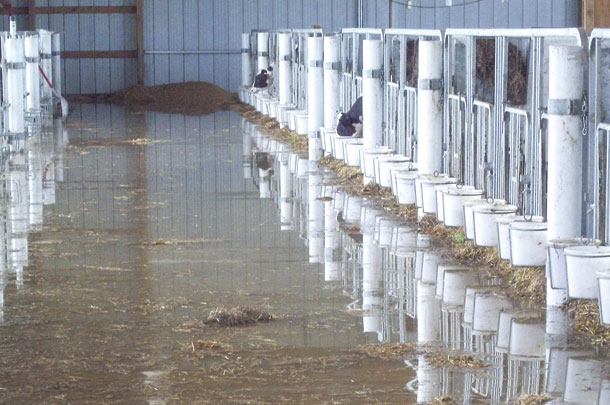An unplanned catastrophe can strike a dairy of any size at any time. A tornado or fire could level facilities and kill livestock in a matter of minutes.
A death or serious illness could remove key employees for days. And a raid by ICE might decimate a dairy’s workforce overnight.
How can dairy managers prepare? What are the issues to consider ahead of time in order to make sure the severity is minimized as much as possible?
Dr. Mike Hutjens, professor of animal sciences emeritus at University of Illinois, has spent decades advising professionals in every single aspect of the industry. His first recommendation is to make sure multiple people on your dairy can do multiple jobs.
1. Cross-train your team
“Cross-training of positions is important in case of illness and personnel problems, especially at the management level,” Hutjens says. Dairy managers can’t afford to have key roles that can only be filled by one person, especially if that individual is you.
2. Create an emergency call list
If your barn is on fire, who’s the first person you call after 911? For larger farms, it’s likely the dairy manager. For smaller operations, it may be your spouse. Do those people know what to do if you alert them to a crisis without you having to spend precious minutes describing what you need from them?
Creating a crisis plan means you should have those conversations well in advance so you can set the steps in motion to get help quickly with only one call and a brief description.
3. Cultivate a team of local dairies
Outside your own employees, no one can care for your cows like a fellow dairyman. Who are the colleagues in your area you could call in the middle of the night during an emergency? Make sure your manager or spouse knows the names and cell phone numbers of these individuals.
Also, make sure those folks aren’t surprised or caught off guard if they get an emergency phone call by confirming their willingness to help in advance. Of course, you’ll be offering to do the same for them if an emergency strikes their dairy.
Hutjens advises dairymen to look for groups based on their feed co-op connections, organizations that are milk-focused or breed associations. Affiliated industries could also encourage and facilitate these connections.
4. Identify key tasks and advanced prep for them
Look at the key tasks of your day and identify ways to plan for a crisis. An example of a key task is feeding your herd.
“Upsizing TMR mixers could allow for larger batches, reducing the number of mixtures and reducing feeding time,” Hutjens counsels. If a crisis occurs, “Dry cows could be fed once a day or every other day if the TMR is stable,” he adds.
While you might not purchase a larger mixer immediately simply to prepare for a crisis, this consideration might come into play the next time you need to upgrade equipment.
“To reduce mixing time, making larger premixtures of protein, byproducts and vitamin-trace mineral (VTM) mixtures can reduce feeding time,” he says.
5. Consider labor needs closely
Every dairyman knows running a dairy is a labor-intensive business. If an ICE raid eliminated 80 percent of your workforce overnight due to detentions and fears of showing up to work, are you prepared?
“If large numbers of labor resources are removed,” Hutjens says, dairies “could shift from 3 times [milking] to 2 times” a day. While this reduces milk yield and therefore profits, it might be a temporary solution in a crisis.
Look at the team of dairies you have developed in your area. You might have to get workers on loan from multiple dairies, and you might have to pay above your regular wages, but those contacts might help you get through a crisis with minimal consequences for your herd.
Case study: The flood of 2010
Glen Meier of Meier Meadows Farm near Ridott, Illinois, faced a crisis on July 25, 2010, that could have wiped out his entire herd. The Pecatonica River that flows around his dairy was flooding.
“When you live in the river bottoms, high water is not an uncommon thing,” Meier explains. His great-grandfather homesteaded the farm more than 100 years earlier. “All those years, we never had water in the buildings.”
At noon that day, water was rising almost 7 inches per hour. “By 2 p.m., we started calling dairymen for help,” he shares.
Catastrophe had also struck Meier Meadows decades earlier. In August of 1965, a tornado destroyed 15 buildings and killed some bred heifers. But Meier admits they weren’t prepared for a flood.
“We didn’t have any plan in place,” he says. “It was nothing we ever considered.”
Meier began calling anyone he knew who had a barn that might not be full. “We had 275 milk cows to place, in addition to calves and yearling heifers.”
His neighbors didn’t have much room – five cows at one location and maybe 10 cows at another. The calls were pretty much the same over and over.
Finally, one friend said she knew of a dairy in Evansville, Wisconsin, 45 minutes away, expanding with a large barn that was almost finished, but wasn’t full yet. “I called Larson Acres even though I didn’t know them at all,” Meier explains. “It was 5 p.m., and Ed Larson immediately offered to drive down and see what we needed.”
Soon after, Larson drove into the long lane at Meier Meadows, which was already under water. Meier was standing in one of the few dry areas left outside the barns. “He opened the door, stepped out of his truck and the first words out of his mouth were, ‘Get ’em outta here.’ I had never met the man, but that’s dairy farmers.”

Teams of local farmers stepped in to move the cattle using trailers and trucks. With the access road to the farm flooded, they ferried the cattle out to the blacktop road almost 2 miles away where semi-trucks were waiting and transferred them in the middle of the road.
“We started loading out at 11 p.m. that night after milking and by 4:30 a.m., they were gone.” The last cattle were removed in 2 feet of water. He remembers, “Farmers were backing up, aiming for a gate and the trailer would float off in the opposite direction due to the current.”
“We had 150 head of youngstock we couldn’t load out,” Meier explains. “We had to chase them across the current and the calves had to swim across. And all of this was happening in the dark.”
“I honestly to this day don’t know how it happened,” Meier says. “Water was waist-deep and you had to push manure away to move.”
Back in Wisconsin, the new barn wasn’t completely ready for cattle. They had freestalls, but no gates and not a single pen ready with bedding. “Larson called every contractor he worked with, and they got the barn ready for us overnight,” Meier says.
“We hauled almost 600 head of cattle off the farm in one night,” Meier recalls. Through it all, they only lost one calf “and it was a bull calf,” he notes. “Everything the book says you shouldn’t do to a cow, we did in 24 hours. We hadn’t fed them, they hadn’t laid down, and they had been hauled a long distance standing for hours without water.”
For the next month, Meier and a few members of his team lived in Wisconsin and helped care for their cows alongside the employees of Larson Acres. “They were just angels,” he says. “We got along so good.” At the same time, friends were cleaning the mess left by the flood at his farm in Illinois. “People worked like slaves and didn’t expect anything in return.”
Water had risen to more than 3 feet deep in the cow sheds. Mud and manure filled every nook and cranny of the parlor and the farm. They bottle-fed 60 calves housed together in one pen.
“I wouldn’t wish what we went through on my worst enemy,” Meier says.
Meier says help poured out of the woodwork. “You have to rely on a network of friends to get it done,” he says. “They are out there, and they come in droves when needed.” Ten cow trailers remained sitting on the road with volunteers ready, but were never used the night of the evacuation.
“It’s a wonderful feeling,” Meier shares. “It shows you how good people can be.”
Today, Glen Meier has welcomed four of his adult children into the business. Jason, Glen Arthur, Becky Jo and Jennifer Meier Busker are continuing the century-old legacy of milking cows and overcoming adversity. “If it wasn’t for them, I wouldn’t be doing this,” Glen says. “They are full partners.”
Meier Meadows has just moved into new facilities 3 miles up the road from the original flooded location. Built to milk 600 cows, they have a new parlor, cross-ventilation barn, manure system and commodity shed all farther away from the river. He adds: “It would take a flood with an ark to put the new location in danger.”
While dairymen are often fiercely independent, a crisis may require both asking for help and accepting assistance.
“Developing an emergency plan with other dairy farms locally would be excellent for sharing labor, equipment, number of cattle that could be taken and feed resources,” Hutjens summarizes. The herd you save could be your own.
“Dairymen, don’t do it alone,” Meier says. “I can’t stress that enough.” ![]()
PHOTO 1: During the summer of 2010, Meier Meadows Farm in Illinois experienced a once-in-a-century flood.
PHOTO 2: As flood waters rose overnight, the dairy hauled off 600 head of cattle, including 275 milking cows, within a 24-hour period. Most of the cows were received and temporarily housed at Larson Acres in Evansville, Wisconsin. Courtesy photos.

-
Karena Elliott
- International Freelance Writer
- Amarillo, Texas







